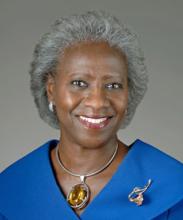
November, 2019
DR. VALANTINE'S FOOD FOR THOUGHT

Hannah A. Valantine, MD Chief Officer for Scientific Workforce Diversity
“You cannot be what you cannot see.” High profile recognition and funding in the sciences offer opportunities to promote research advancements representing a diverse array of fields, perspectives, and problem solving. Most importantly, premiere awards help to support and inspire the next generation of researchers, creating an ‘awareness to awards’ cycle that may be important in sustainably addressing long established disparities. In this month’s issue, I highlight instances where ensuring adequate recognition and remuneration of diverse groups within science and the research itself is a central issue for many organizations which can offer insights into the depth of the challenges and possible solutions.
A 'Nobel Struggle': The 2019 Nobel Prizes Grapple with STEM Diversity
The 2019 Nobel Prizes were recently announced, awarding various researchers in STEM fields. However, Esther Duflo was the sole woman awarded a Nobel Prize in the sciences this year, and only the second woman to win in the field of economics in the award’s 50-year history. This year continued a trend reflecting the lack of diversity in race, gender, and geography, despite the Royal Swedish Academy of Sciences making changes to help the process become more inclusive.
Although the Academy invited more women to be a part of its selection process and asked people to consider diversity, there was only a modest increase in the number of women nominated. The institution also reported their female nominators are no more likely to nominate women than men. Some believe this could reflect the fear of committee members believing they may have to contend with arguments related to compromising excellence by visibly supporting women. In conjunction with fewer women and minority researchers filling tenure track positions, and their scientific advances, which tend to focus on specific communities, potentially being less appreciated than those that generate international recognition, it is clear the challenges are significant.
Overall, this echoes ideas that organizations interested in increasing diversity must implement sustained, well-thought out strategies along with guardrails to assure parties can assert themselves without being penalized.
Topic Choice Contributes to the Lower Rate of NIH Awards to African-American/Black Scientists
A recent Science Advances article, authored by members of the NIH, including myself, investigated the disparity between Black applicants and White applicants in successful grant applications. The study focused on successful applications for R01 grants submitted between 2011 and 2015. The researchers analyzed keywords in the research topics in over 157,000 grant applications. Results suggested some of the less favored topics for gaining funding support had words like ‘socioeconomic status’, ‘pregnancy’, and ‘physical activity’— which align themselves with more community-oriented research topics that African American scientists may be more likely to pursue. This finding highlights that a small portion of the ‘successful grant’ disparity between groups may be due to topic choice and how the topics are valued by grant reviewers. NIH is also addressing the other contributing factors.
NIH Supports Centers Seeking to Diversify a Reference Human Genome
The Human Genome Project, which decoded the human genome in 2002, was a major step forward for biomedical research and precision medicine, but the resulting sequence only reflected the genetic information of a few volunteers. To enhance the diversity and accuracy of a newly developing reference genome, the NIH has granted 29.5 million dollars to Washington University School of Medicine in St. Louis and collaborating institutions. Called the “Human Pangenome Reference Sequencing Project”, the initiative’s mission is to use new technologies and advanced sequencing methods to decode a diverse set of genes from people, forming an encyclopedic ‘human pangenome’ to better reflect worldwide human populations. At its core, the project aims to represent the genetic information of 350 individuals. This new round of sequencing may open the door to more promising outcomes in science and medicine, as newer technologies allow for highly advanced sequencing which was difficult to capture in the initial project—making the new genome more complete as well as diverse.
Ambassadors? Role Models? The Next Generation of Diverse Scientists is Here.
People need to see themselves reflected in the prominent positions within a field to spur confidence and sustain representation. Because of this, initiatives such as the American Association for the Advancement of Science’s (AAAS) IF/THEN Ambassadors Program are direly important. In particular, this initiative empowers women in STEM by highlighting innovators and inspiring the next generation of aspiring STEM leaders. It connects 125 women from a various STEM fields who offer their time, filling the role of high-profile role models and engaging with middle school girls in a variety of educational spaces. Importantly, a vast array of STEM fields is represented including: research and development, sports and recreation, finance, fashion, gaming, engineering and host of others. Last month the AAAS IF/THEN Ambassadors gathered for an in-person summit in Dallas to receive science communication training and create personal press kits that highlight their stories which take enhance their approaches to outreach. Additionally, the robust materials highlighting their images and stories will be stored as part of a collection accessible to the media, educators, and other interested parties interested in portraying real women and girls in STEM.

The links above are pulled from the top news articles trending on the subject of diversity in science and technology.
The stories selected are not a reflection of the views of the National Institutes of Health.

